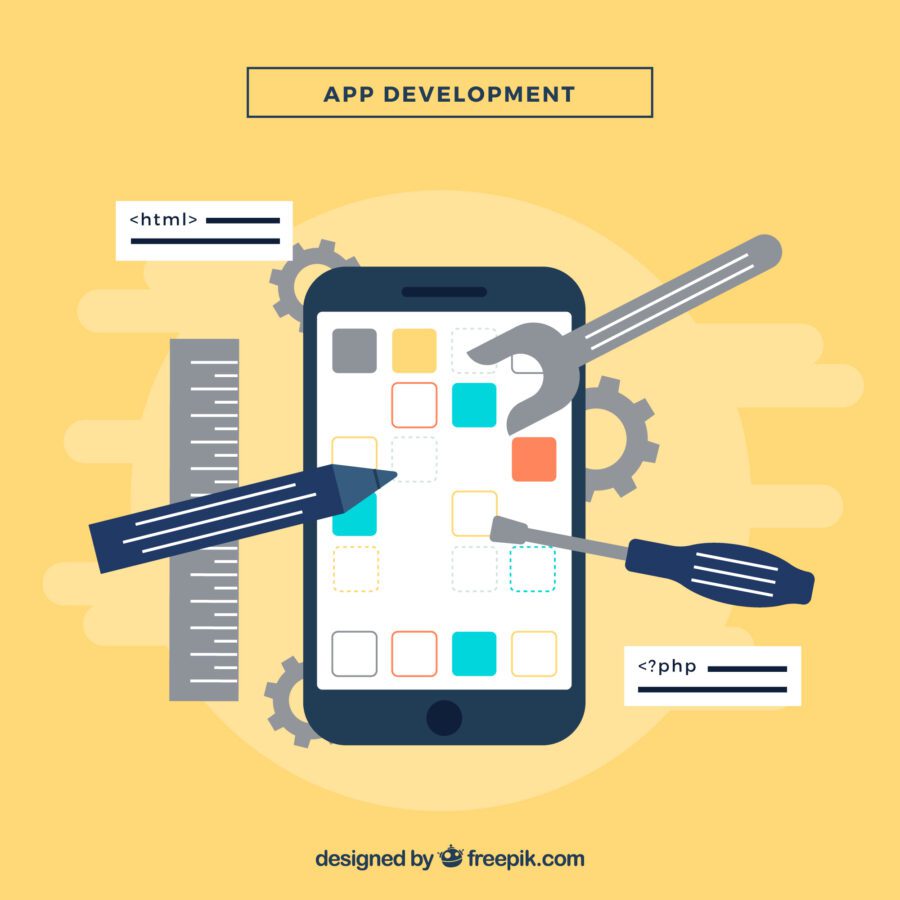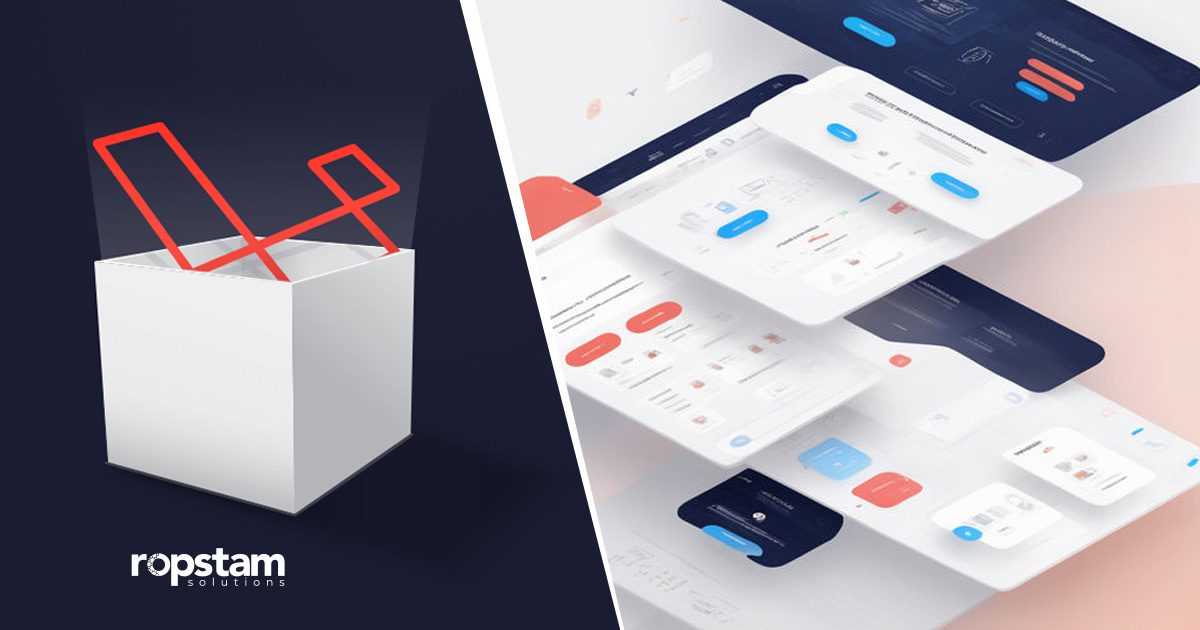Vue.js is one of the most popular JavaScript frameworks for front-end development. Thanks to its ease of use and gentle learning curve, Vue is preferred by countless front-end developers. For creating visually appealing user interfaces, a Vue UI component library is considered the building block that accelerates and optimizes the web app development process.
But with so many options available, selecting the most appropriate component library for specific use cases can turn out to be a difficult task. If you are searching for the best Vue UI component libraries, keep on reading for a comprehensive analysis.
What is a Vue component library?
A Vue component library is a collection of reusable Vue components that can be easily integrated into Vue applications. Component libraries provide pre-built UI elements like buttons, menus, modals, etc., that speed up development by eliminating the need to build common components from scratch. By enabling consistent UI/UX across applications, such third-party libraries are termed essential for rapidly building Vue apps at scale.
Top 15 Vue UI component libraries & frameworks to make front-end developers life easier
As the Vue.js community continues to grow, here I have compiled a list of the top component libraries and a few frameworks to help you make an informed decision when it comes to creating top-notch user interfaces:
| Vue Component Library |
Key Attributes |
| Bootstrap Vue |
|
| Quasar |
|
| Vue Material |
|
| Vux |
|
| Fish UI |
|
| Buefy |
|
| Vuesax |
|
| Ionic Vue |
|
| Vuetify |
|
| Element Plus |
|
| Ant Design Vue |
|
| PrimeVue |
|
| iView |
|
| Keen UI |
|
| VueTailwind |
|
1) Bootstrap Vue:

Bootstrap Vue
Bootstrap Vue is a comprehensive library that blends the functionality of Bootstrap with the robustness of Vue.js. It’s designed to help developers create responsive, mobile-first projects on the web. It’s ideal for developers who want to leverage Bootstrap’s popularity with Vue’s reactivity to create interactive, user-friendly web applications that look good on any device.
2) Quasar:
Quasar is a high-performance, feature-rich framework designed for Vue.js. The framework offers a powerful UI kit, which makes it easier to build responsive single-page applications, server-side rendered apps, progressive web apps, mobile apps using Cordova, and even Electron-based desktop apps.

Quasar
It’s an all-in-one solution for developers who want to write code once and simultaneously create apps for multiple platforms.
3) Vue Material:
Vue Material is a lightweight framework built according to the Material Design specification, which helps you build robust and beautiful Vue applications. By inheriting the features of both Vue.js and Material Design, it gives developers a fast way to build eye-catching, scalable, and high-quality UIs for web applications.
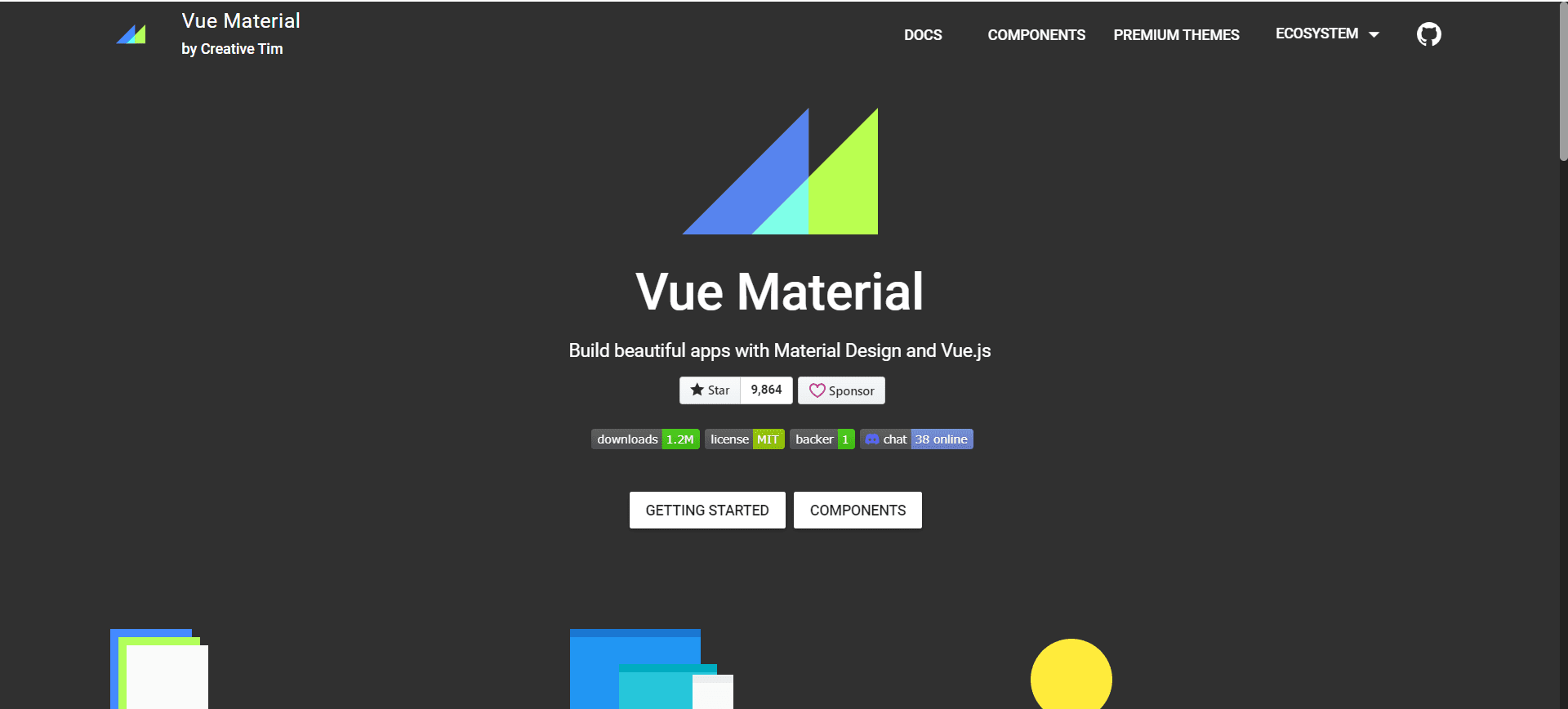
Vue Material
Its primary use case is for developers who want a material design look and feel for their Vue.js applications.
4) Vux:

Vux
Vux is a Vue.js mobile UI component library based on WeUI design. It provides numerous pre-built components that follow the WeChat design guidelines. With this UI component library, developers can quickly build mobile web applications that mimic the look and feel of a native application on WeChat. This makes it a suitable choice, particularly for projects that aim to provide a native-like user experience on mobile web browsers, especially within WeChat.
5) Fish UI:
It is a well-known Vue.js UI toolkit that provides a set of high-quality components based on Vue.js and CSS modules. It provides a collection of essential UI components, ensuring a consistent and efficient developer experience.
Even though the lack of documentation is a major drawback, it is still perfect for developers who want to create modern, clean, and simple web applications with Vue.js, especially those who prefer using CSS modules for styling.
6) Buefy:

Buefy
Buefy is a responsive UI component library that combines Vue.js and Bulma, a modern CSS framework. It offers lightweight, customizable components that are easy to use and integrate into Vue.js applications. Needless to say, it’s an excellent choice for developers who want to build elegant Vue.js applications with a clean and beautiful UI while keeping the initial setup simple and lightweight.
7) Vuesax:
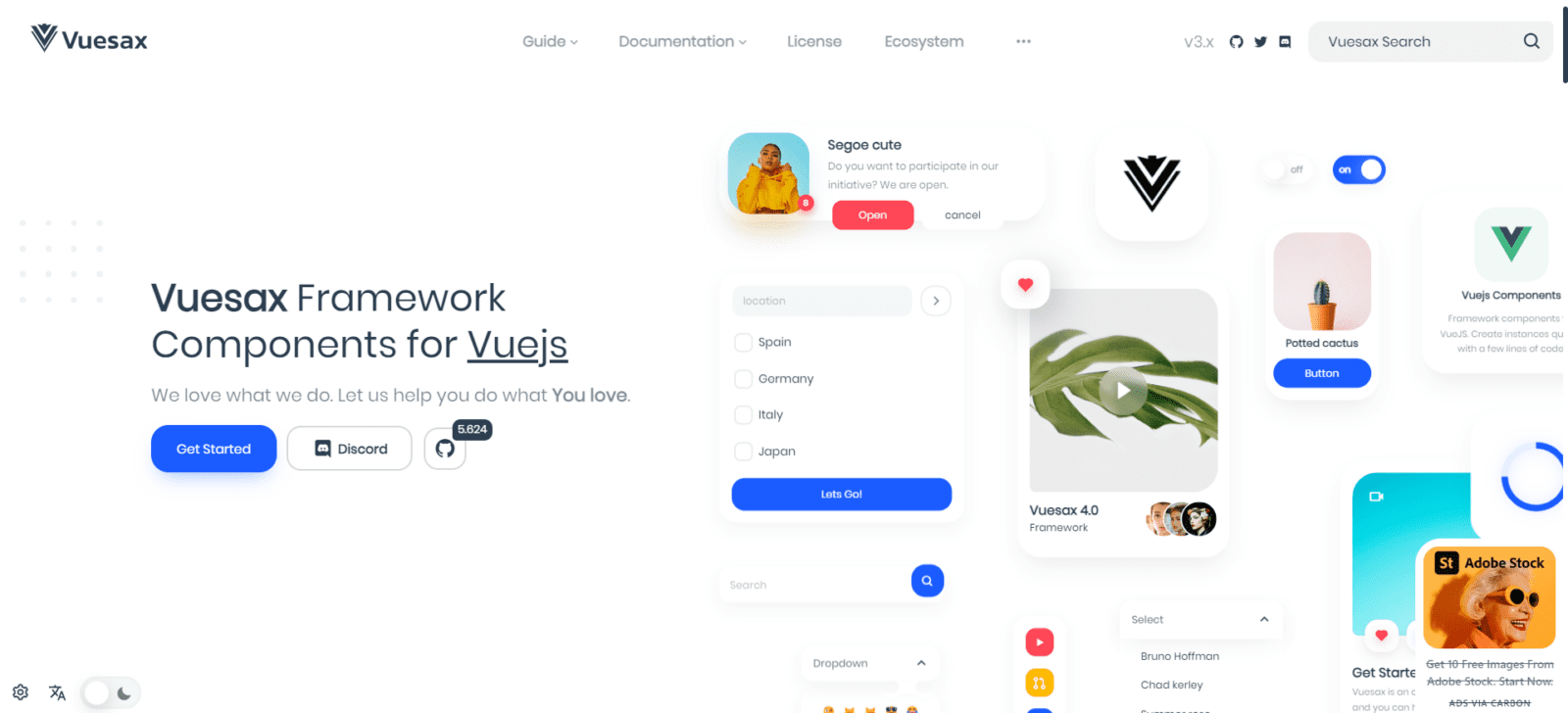
Vuesax
Vuesax is a unique and reusable Vue.js component library that allows developers to build web applications faster. With Vuesax, developers can focus more on functionality rather than design. It provides a range of components with unique designs, which can be customized to fit the brand’s style and color scheme, making it a perfect choice for building high-quality Vue.js applications that stand out.
8) Ionic Vue:

Ionic Vue
Ionic Vue, a native Vue version of Ionic Framework, is a library of pre-designed components that allows developers to build mobile applications in Vue.js. It benefits from the robustness of Vue.js and the versatility of Ionic. It’s best suited for developers who want to use Vue.js to build high-quality, cross-platform mobile apps with a single codebase.
9) Vuetify:

Vuetify
Vuetify is a revered Vue UI library that follows the Material Design specification. It provides clean, semantic, and reusable components that make building application UIs a breeze. The library is perfect for developers who want to create eye-catching, consistent, and reliable web applications using Vue.js and Material Design.
10) Element Plus:
A robust Vue.js desktop UI library, Element Plus provides a rich set of high-quality, out-of-the-box components. It’s ideal for developing Vue.js applications that require a desktop-like user experience.

Element Plus
Thanks to its support for and compatibility with the Vue 3 framework, building complex UI becomes simplistic. Elements Plus boasts features like internationalization, varying themes, and dark mode options.
11) Ant Design Vue:

Ant Design Vue
Ant Design Vue is a set of high-quality Vue components that follow Ant Design specifications. It provides an enterprise-class UI design language for web applications. It’s preferred by developers who are looking to build sophisticated and modern Vue.js applications that adhere to established design patterns.
12) PrimeVue:

PrimeVue
Another useful library, PrimeVue, offers a rich set of open-source UI components for Vue. It provides over 70 flexible, customizable components that can be used to build elegant and flexible user interfaces in Vue.js applications. It’s suitable for developers who want to create advanced UIs without having to build each component from scratch.
13) iView:
Regarded as a high-quality UI toolkit based on Vue.js, iView provides a set of high-quality components and an automated workflow for Vue.js. iView is chosen in scenarios such as efficient and easy-to-use web applications with a consistent design language.
14) Keen UI:
Keen UI is a lightweight Vue.js UI library with a simple API inspired by Google’s Material Design. It provides essential UI components with a focus on simplicity and ease of use. It’s perfect for developers building interactive UIs for Vue.js applications that follow Material Design principles.
15) VueTailwind:
It is a utility-first CSS framework for rapidly building custom user interfaces in Vue.js. It provides low-level utility classes that let you build completely custom designs without leaving your HTML. This library is perfect for you if you want to have complete control over the UI without writing any CSS rules or JavaScript.
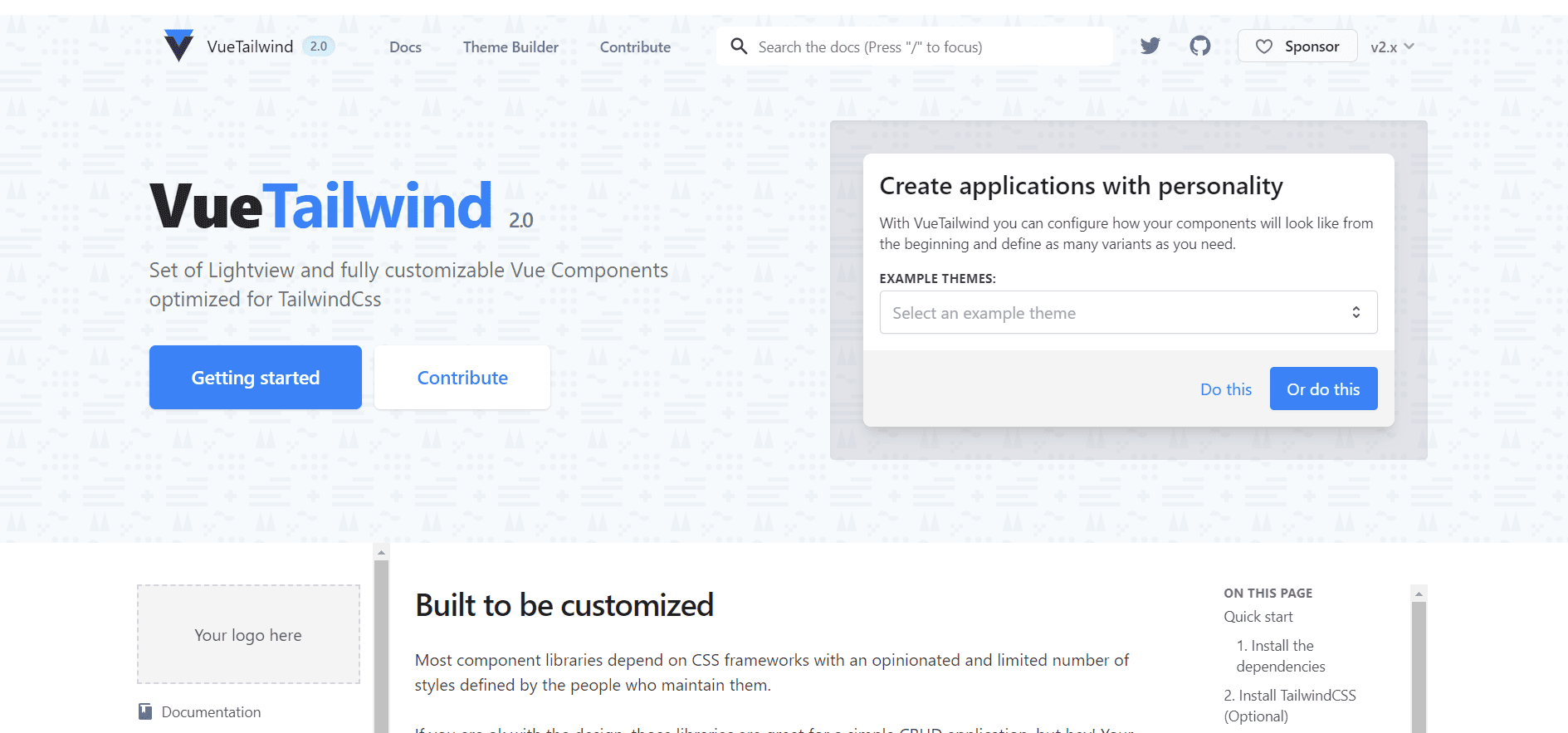
VueTailwind
How to choose the best Vue UI component library?
By now, you must have grasped the Vue component libraries concept and how they are extremely useful in crafting high-level user interfaces like charts without a fuss. But with so many options readily available, one question every Vue.js developer asks is how to select the ideal component library.
Lucky for you, here I have compiled a step-by-step guide to make this process simpler for you:
Step 1: Evaluate your project requirements
The first step to choosing the right Vue component library is to evaluate your specific project needs. Consider the scale of your project, the complexity of the UI you want to build, and the specific components you need. For instance, if you’re building a mobile-first application, you might prefer a library like Vux or Ionic Vue that specializes in mobile UI components.
Step 2: Check the library’s component range
The range of components offered by the library is an important factor. A comprehensive library like Vuetify or Element Plus, which offer a wide array of pre-built components, can significantly speed up development time. Do check if the library provides all the UI components that your application requires.
Step 3: Consider customizability
Your UI library should also allow for easy customization to meet your brand guidelines. Libraries like VueTailwind and Ant Design Vue stand out in this aspect, as they offer extensive customization options, enabling you to adjust the look and feel of components to match your brand’s style and color scheme.
Step 4: Assess the library’s performance and size
Performance is a key factor in user experience. Libraries like Quasar and Buefy are known for their performance and lightweight nature. Before making the final decision, you must check the size of the library, as it can affect your application’s load time. A smaller library ensures your application remains light and loads faster.
Step 5: Check documentation and community support
Good documentation and active community support can be a lifesaver when you encounter problems or need to learn more about using the library. PrimeVue and iView, for example, are among those libraries that have extensive documentation and a vibrant community.
Step 6: Look into the library’s future development
Lastly, you should also consider the library’s commitment to future development. Regular updates indicate a strong commitment to maintaining the library and ensuring compatibility with future Vue.js versions. Therefore, you should check its update frequency and whether the library keeps up with the latest Vue.js releases.
Why choose Ropstam Solutions for your next Vue.js project?
Vue.js UI component libraries are must-haves for developers in order to create user-friendly, aesthetically pleasing, and visually attractive interfaces. From Quasar to iView, there are a range of options available that you can utilize. The meticulous process of component library selection encapsulates understanding the Vue project’s scope, checking its range of components, accessing the level of customizability, and verifying the community support.
Ready to take your front-end project to new heights? Ropstam Solutions offers premier Vue.js development services. With our skilled team and proven track record, success is guaranteed. Contact us now to get started!




